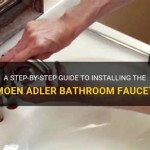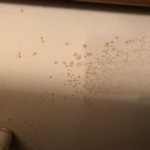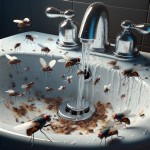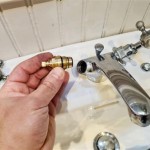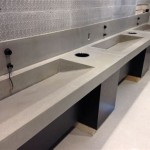How To Get Black Mould Off Bathroom Ceiling
Black mould, scientifically known as *Stachybotrys chartarum*, is a type of fungus that thrives in damp and humid environments. Bathrooms, due to their frequent use of water and often inadequate ventilation, are particularly susceptible to black mould growth, especially on the ceiling. Addressing black mould promptly and effectively is crucial, not only for aesthetic reasons but also for maintaining a healthy living environment. Neglecting black mould can lead to respiratory problems, allergies, and other health concerns. This article provides a comprehensive guide on safely and effectively removing black mould from a bathroom ceiling.
Before commencing any mould removal process, it is imperative to understand the potential health risks associated with black mould exposure. Mould spores can become airborne during the cleaning process, and inhalation can trigger various health issues, particularly in individuals with pre-existing respiratory conditions, allergies, or weakened immune systems. Common symptoms of mould exposure include coughing, sneezing, runny nose, sore throat, skin rashes, and eye irritation. In severe cases, exposure to certain types of mould can lead to more serious respiratory infections and neurological problems. Therefore, prioritizing safety and taking necessary precautions is paramount throughout the entire removal process.
Preparation is key to a successful and safe mould removal project. This involves gathering the necessary protective gear, preparing the work area, and selecting the appropriate cleaning solutions. Insufficient preparation can lead to ineffective cleaning, re-growth of mould, and potential health hazards. The following steps outline the essential preparations required before addressing black mould on a bathroom ceiling.
Essential Preparations for Mould Removal
The first step in preparing for mould removal is ensuring adequate ventilation. Open windows and doors to allow fresh air to circulate through the bathroom. If natural ventilation is insufficient, consider using a fan to improve airflow. Proper ventilation helps to reduce the concentration of airborne mould spores and minimizes the risk of inhalation. Furthermore, turning on the bathroom exhaust fan during and after the cleaning process can help to remove moisture and prevent future mould growth.
Personal protective equipment (PPE) is crucial for safeguarding against mould exposure during the cleaning process. At a minimum, a respirator mask rated N95 or higher is required to filter out airborne mould spores. Goggles or safety glasses should be worn to protect the eyes from irritation and splashes. Gloves made of non-porous material, such as rubber or nitrile, are essential to prevent direct skin contact with mould and cleaning solutions. Consider wearing old clothing that can be easily washed or discarded after the cleaning process to avoid spreading mould spores to other areas of the house.
To prevent the spread of mould spores to other areas of the home, it is important to properly contain the work area. Cover the floor with plastic sheeting secured with painter's tape. This will protect the flooring from cleaning solutions and prevent mould spores from settling on the surface. Remove any items from the bathroom that are not essential to the cleaning process, such as towels, toiletries, and decorative items. These items can harbor mould spores and should be thoroughly cleaned or discarded if they show signs of mould contamination.
Choosing the right cleaning solution is critical for effectively removing black mould from the bathroom ceiling. Various options are available, ranging from natural remedies to commercially available mould removal products. The choice of cleaning solution will depend on the severity of the mould infestation and personal preferences. It is important to select a solution that is both effective at killing mould and safe for use in a bathroom environment. Always test the cleaning solution in an inconspicuous area of the ceiling before applying it to the entire surface to ensure it does not damage the paint or finish.
Common Cleaning Solutions for Black Mould Removal
Bleach is a commonly used disinfectant and mould-killing agent. A diluted bleach solution, typically consisting of one part bleach and ten parts water, can be effective for removing surface mould. However, it is important to note that bleach only kills mould on the surface and does not penetrate porous materials. Therefore, it may not be effective for deep-seated mould infestations. When using bleach, always ensure adequate ventilation and avoid mixing it with ammonia or other cleaning products, as this can create toxic fumes. Furthermore, bleach can discolor or damage certain surfaces, so it is essential to test it in an inconspicuous area before applying it to the entire ceiling.
Vinegar is a natural and less harsh alternative to bleach for mould removal. White distilled vinegar is acidic and can effectively kill many types of mould. Simply spray undiluted vinegar onto the affected area and let it sit for about an hour before scrubbing and rinsing. Vinegar is generally safe for use on most surfaces, but it is still advisable to test it in an inconspicuous area first. While vinegar is effective at killing mould, it may not be as effective as bleach at removing stains.
Baking soda is another natural and versatile cleaning agent that can be used to remove mould. It is mildly abrasive and can help to scrub away mould stains. To use baking soda for mould removal, mix it with water to form a paste and apply it to the affected area. Let the paste dry completely before scrubbing it off with a brush. Baking soda is also an effective deodorizer and can help to absorb any lingering mould odors. Furthermore, it is non-toxic and safe for use around children and pets.
Commercially available mould removal products are specifically formulated to kill and remove mould effectively. These products typically contain stronger chemicals than natural alternatives and may be more effective for severe mould infestations. When using commercial mould removal products, it is crucial to follow the manufacturer's instructions carefully. Ensure adequate ventilation and wear appropriate protective gear, as these products can be irritating to the skin, eyes, and respiratory system. Choose a product that is specifically designed for use on ceilings and that is safe for the type of surface being cleaned.
The Mould Removal Process
Once the preparations are complete and the chosen cleaning solution has been selected, the actual mould removal process can begin. This involves applying the cleaning solution to the affected area, scrubbing away the mould, and thoroughly rinsing and drying the ceiling. The following steps outline the process in detail.
Spray the chosen cleaning solution generously onto the mould-affected area of the bathroom ceiling. Ensure that the entire surface is thoroughly saturated. Allow the solution to dwell on the surface for the recommended amount of time, as specified by the manufacturer or based on the type of cleaning solution used. For bleach solutions, a dwell time of 10-15 minutes is typically sufficient. For vinegar or baking soda paste, a dwell time of at least one hour is recommended. The dwell time allows the cleaning solution to penetrate the mould and kill the spores.
After the dwell time has elapsed, use a scrub brush, sponge, or cloth to scrub the mould off the ceiling. Apply moderate pressure and work in small sections at a time. For stubborn mould stains, use a stiffer brush or consider reapplying the cleaning solution and allowing it to dwell for a longer period. Be careful not to damage the ceiling surface while scrubbing. Avoid using abrasive cleaners or tools that could scratch or damage the paint or finish.
Once the mould has been thoroughly scrubbed away, rinse the ceiling with clean water to remove any remaining cleaning solution and mould residue. Use a clean sponge or cloth to wipe the ceiling until it is completely free of residue. Ensure that all traces of the cleaning solution are removed, as any remaining residue could attract dirt and moisture, potentially leading to future mould growth. After rinsing, dry the ceiling thoroughly with a clean towel or cloth. Alternatively, allow the ceiling to air dry, but ensure adequate ventilation to prevent moisture from lingering.
After the initial cleaning, inspect the ceiling carefully for any remaining mould stains or signs of mould growth. If necessary, repeat the cleaning process to remove any stubborn stains or areas that were missed during the first cleaning. Pay particular attention to corners, edges, and areas where moisture tends to accumulate. If the mould infestation is severe or deep-seated, it may be necessary to consult with a professional mould remediation specialist. Professionals have the expertise and equipment to safely and effectively remove mould from difficult-to-reach areas and to address underlying moisture problems that may be contributing to mould growth.
Preventing future mould growth is crucial for maintaining a healthy bathroom environment. The most effective way to prevent mould growth is to control moisture levels and ensure adequate ventilation. After showering or bathing, always turn on the bathroom exhaust fan and leave it running for at least 20 minutes to remove excess moisture. Wipe down wet surfaces, such as shower walls and the ceiling, to prevent water from accumulating. Repair any leaks in the plumbing or roof promptly to prevent water damage. Consider using a dehumidifier in the bathroom to reduce humidity levels, especially in areas with poor ventilation.
Regularly inspect the bathroom ceiling for signs of mould growth. Look for discoloration, stains, or musty odors. Addressing any minor mould growth promptly can prevent it from spreading and becoming a more serious problem. Clean the bathroom regularly, paying particular attention to areas that are prone to moisture accumulation. Use mould-resistant paint in the bathroom to help prevent mould growth. Mould-resistant paints contain additives that inhibit the growth of mould and mildew.
By following these guidelines, one can effectively remove black mould from a bathroom ceiling and prevent future growth. Prioritizing safety, preparing the work area thoroughly, selecting the appropriate cleaning solutions, and maintaining a dry and well-ventilated bathroom environment are all essential for successful mould removal and prevention.

Black Mould Removal The Right Way

Ceiling Mold Growth Learn The Cause And How To Prevent It Environix

Mold On Bathroom Ceiling How To Clean Off

Bathroom Ceiling Mold Removal When To Clean Call Branch Environmental

How To Remove Black Mold From A Bathroom Ceiling

Ceiling Mold Growth Learn The Cause And How To Prevent It Environix

How To Get Rid Of Mould From Your Ensuite Ceiling Independent Ie

Black Mold On Your Bathroom Ceiling Read This First

My Bathroom Ceiling Has Black Mould Growing On It What Should I Do

My Bathroom Ceiling Has Black Mould Growing On It What Should I Do
Related Posts
